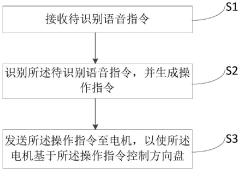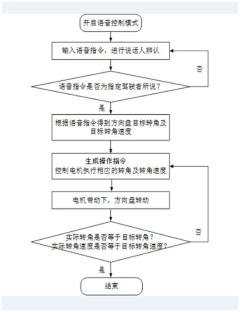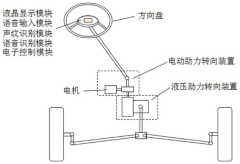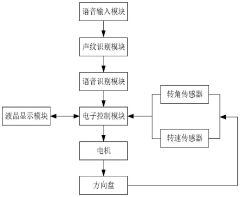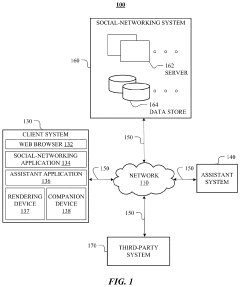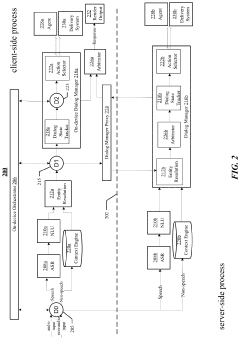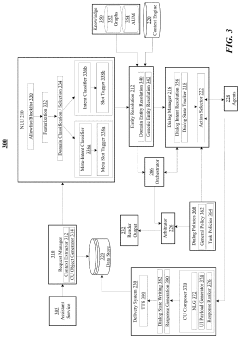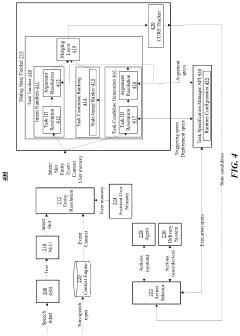Advanced Steering Wheel Controls: Voice Command Integration
JUL 18, 20259 MIN READ
Generate Your Research Report Instantly with AI Agent
Patsnap Eureka helps you evaluate technical feasibility & market potential.
Steering Wheel Evolution and Integration Goals
The steering wheel has undergone significant evolution since its inception in the automotive industry. Initially designed as a simple control mechanism for vehicle direction, it has transformed into a sophisticated interface integrating multiple functions. The early 20th century saw the introduction of basic steering wheels, primarily focused on directional control. As automotive technology advanced, steering wheels began incorporating additional features such as horn buttons and cruise control switches.
The late 20th and early 21st centuries marked a pivotal shift in steering wheel design, with the integration of audio and communication controls. This evolution aimed to enhance driver convenience and reduce distractions by allowing drivers to manage various vehicle functions without removing their hands from the wheel. The advent of digital displays and touch-sensitive surfaces further expanded the steering wheel's capabilities, providing drivers with access to a wider range of vehicle information and controls.
Recent years have witnessed a growing emphasis on advanced driver assistance systems (ADAS) and semi-autonomous driving features. This has led to the incorporation of sensors and indicators within the steering wheel to support functions such as lane departure warnings and adaptive cruise control. The integration of haptic feedback systems has also emerged as a means to enhance driver awareness and safety.
The current focus on voice command integration represents the next frontier in steering wheel evolution. This technology aims to further reduce driver distraction by enabling hands-free control of various vehicle systems. The goal is to create a seamless interface between the driver and the vehicle, where voice commands can be used to adjust climate settings, navigate routes, make phone calls, and control infotainment systems, all while maintaining a firm grip on the steering wheel.
Looking ahead, the integration goals for advanced steering wheel controls with voice command integration are multifaceted. Firstly, there is a push towards improving natural language processing capabilities to enhance the accuracy and responsiveness of voice commands. Secondly, developers are working on expanding the range of functions that can be controlled through voice commands, potentially including more complex vehicle settings and even autonomous driving features.
Another key objective is to seamlessly integrate voice command functionality with existing tactile controls, creating a hybrid interface that caters to different driver preferences and situations. This involves developing intuitive voice activation methods that do not interfere with traditional steering wheel operations. Additionally, there is a focus on personalizing the voice command experience, allowing the system to adapt to individual driver preferences and speech patterns over time.
The late 20th and early 21st centuries marked a pivotal shift in steering wheel design, with the integration of audio and communication controls. This evolution aimed to enhance driver convenience and reduce distractions by allowing drivers to manage various vehicle functions without removing their hands from the wheel. The advent of digital displays and touch-sensitive surfaces further expanded the steering wheel's capabilities, providing drivers with access to a wider range of vehicle information and controls.
Recent years have witnessed a growing emphasis on advanced driver assistance systems (ADAS) and semi-autonomous driving features. This has led to the incorporation of sensors and indicators within the steering wheel to support functions such as lane departure warnings and adaptive cruise control. The integration of haptic feedback systems has also emerged as a means to enhance driver awareness and safety.
The current focus on voice command integration represents the next frontier in steering wheel evolution. This technology aims to further reduce driver distraction by enabling hands-free control of various vehicle systems. The goal is to create a seamless interface between the driver and the vehicle, where voice commands can be used to adjust climate settings, navigate routes, make phone calls, and control infotainment systems, all while maintaining a firm grip on the steering wheel.
Looking ahead, the integration goals for advanced steering wheel controls with voice command integration are multifaceted. Firstly, there is a push towards improving natural language processing capabilities to enhance the accuracy and responsiveness of voice commands. Secondly, developers are working on expanding the range of functions that can be controlled through voice commands, potentially including more complex vehicle settings and even autonomous driving features.
Another key objective is to seamlessly integrate voice command functionality with existing tactile controls, creating a hybrid interface that caters to different driver preferences and situations. This involves developing intuitive voice activation methods that do not interfere with traditional steering wheel operations. Additionally, there is a focus on personalizing the voice command experience, allowing the system to adapt to individual driver preferences and speech patterns over time.
Market Analysis for Smart Steering Wheel Controls
The market for smart steering wheel controls with voice command integration is experiencing significant growth, driven by increasing consumer demand for advanced in-vehicle technology and enhanced driving experiences. This trend is further fueled by the automotive industry's shift towards connected and autonomous vehicles, where intuitive and hands-free interfaces are becoming essential.
The global market for smart steering wheel controls is projected to expand at a compound annual growth rate (CAGR) of 8.5% from 2021 to 2026. This growth is attributed to the rising adoption of advanced driver assistance systems (ADAS) and the integration of artificial intelligence (AI) in automotive technologies. The voice command integration segment within this market is expected to witness even higher growth rates, with some estimates suggesting a CAGR of over 12% during the same period.
Key factors driving market demand include improved safety features, enhanced driver convenience, and the growing preference for connected car technologies. Smart steering wheel controls with voice command integration allow drivers to maintain focus on the road while accessing various vehicle functions, navigation systems, and infotainment features. This aligns with the increasing emphasis on reducing driver distraction and improving overall road safety.
The market is segmented based on vehicle type, with passenger cars currently dominating the smart steering wheel controls market. However, the commercial vehicle segment is expected to witness rapid growth in the coming years, as fleet operators recognize the benefits of these technologies in improving driver efficiency and vehicle management.
Geographically, North America and Europe are leading the market due to high consumer awareness, stringent safety regulations, and the presence of major automotive manufacturers investing in advanced technologies. The Asia-Pacific region, particularly China and India, is anticipated to emerge as a lucrative market for smart steering wheel controls, driven by increasing vehicle production and rising disposable incomes.
Consumer preferences are shifting towards more intuitive and personalized in-vehicle experiences. This has led to the development of advanced voice recognition systems that can understand natural language commands and adapt to individual user preferences. The integration of AI and machine learning algorithms is further enhancing the capabilities of these systems, allowing for more accurate and context-aware responses.
The market is also witnessing a trend towards the integration of biometric sensors in steering wheels, which can monitor driver alertness and health parameters. This development is expected to create new opportunities for smart steering wheel control manufacturers, as it combines safety features with advanced user interface technologies.
The global market for smart steering wheel controls is projected to expand at a compound annual growth rate (CAGR) of 8.5% from 2021 to 2026. This growth is attributed to the rising adoption of advanced driver assistance systems (ADAS) and the integration of artificial intelligence (AI) in automotive technologies. The voice command integration segment within this market is expected to witness even higher growth rates, with some estimates suggesting a CAGR of over 12% during the same period.
Key factors driving market demand include improved safety features, enhanced driver convenience, and the growing preference for connected car technologies. Smart steering wheel controls with voice command integration allow drivers to maintain focus on the road while accessing various vehicle functions, navigation systems, and infotainment features. This aligns with the increasing emphasis on reducing driver distraction and improving overall road safety.
The market is segmented based on vehicle type, with passenger cars currently dominating the smart steering wheel controls market. However, the commercial vehicle segment is expected to witness rapid growth in the coming years, as fleet operators recognize the benefits of these technologies in improving driver efficiency and vehicle management.
Geographically, North America and Europe are leading the market due to high consumer awareness, stringent safety regulations, and the presence of major automotive manufacturers investing in advanced technologies. The Asia-Pacific region, particularly China and India, is anticipated to emerge as a lucrative market for smart steering wheel controls, driven by increasing vehicle production and rising disposable incomes.
Consumer preferences are shifting towards more intuitive and personalized in-vehicle experiences. This has led to the development of advanced voice recognition systems that can understand natural language commands and adapt to individual user preferences. The integration of AI and machine learning algorithms is further enhancing the capabilities of these systems, allowing for more accurate and context-aware responses.
The market is also witnessing a trend towards the integration of biometric sensors in steering wheels, which can monitor driver alertness and health parameters. This development is expected to create new opportunities for smart steering wheel control manufacturers, as it combines safety features with advanced user interface technologies.
Current Challenges in Steering Wheel Interface Design
The integration of advanced steering wheel controls with voice command functionality presents several significant challenges in interface design. One of the primary obstacles is balancing the need for comprehensive functionality with the requirement for a clean, uncluttered steering wheel layout. As vehicles become more technologically advanced, there is a growing demand for more controls to be accessible from the steering wheel. However, an overabundance of buttons and switches can lead to driver confusion and potential safety hazards.
Another challenge lies in ensuring that voice command integration is seamless and intuitive. While voice control offers hands-free operation, it must be designed to work flawlessly in various acoustic environments within the vehicle, accounting for road noise, passenger conversations, and audio system output. The system needs to accurately interpret commands across different accents, languages, and speech patterns, which requires sophisticated natural language processing capabilities.
Ergonomics plays a crucial role in steering wheel interface design. The placement of controls must be optimized for ease of use without compromising the driver's grip or ability to steer effectively. This becomes particularly challenging when incorporating touch-sensitive surfaces or gesture controls, as these require precise finger movements that could potentially interfere with steering stability.
The issue of driver distraction is paramount in steering wheel interface design. While the goal is to provide easy access to various vehicle functions, designers must ensure that interacting with these controls does not divert the driver's attention from the road for extended periods. This necessitates a delicate balance between functionality and simplicity, with a focus on creating interfaces that can be operated largely by muscle memory and peripheral vision.
Customization and adaptability present another set of challenges. Different drivers have varying preferences and needs, which calls for interfaces that can be personalized. However, implementing such flexibility without compromising the intuitiveness of the design or introducing complexity in the vehicle's software systems is a significant hurdle.
Durability and reliability of the interface components are also critical considerations. Steering wheel controls are subject to frequent use and must withstand various environmental conditions, from extreme temperatures to exposure to moisture and dust. Ensuring long-term functionality while maintaining a premium feel and appearance adds another layer of complexity to the design process.
Lastly, the integration of haptic feedback into steering wheel controls presents both opportunities and challenges. While haptic feedback can enhance the user experience and provide confirmation of inputs without visual distraction, implementing it effectively without introducing unwanted vibrations or compromising the overall feel of the steering wheel requires sophisticated engineering solutions.
Another challenge lies in ensuring that voice command integration is seamless and intuitive. While voice control offers hands-free operation, it must be designed to work flawlessly in various acoustic environments within the vehicle, accounting for road noise, passenger conversations, and audio system output. The system needs to accurately interpret commands across different accents, languages, and speech patterns, which requires sophisticated natural language processing capabilities.
Ergonomics plays a crucial role in steering wheel interface design. The placement of controls must be optimized for ease of use without compromising the driver's grip or ability to steer effectively. This becomes particularly challenging when incorporating touch-sensitive surfaces or gesture controls, as these require precise finger movements that could potentially interfere with steering stability.
The issue of driver distraction is paramount in steering wheel interface design. While the goal is to provide easy access to various vehicle functions, designers must ensure that interacting with these controls does not divert the driver's attention from the road for extended periods. This necessitates a delicate balance between functionality and simplicity, with a focus on creating interfaces that can be operated largely by muscle memory and peripheral vision.
Customization and adaptability present another set of challenges. Different drivers have varying preferences and needs, which calls for interfaces that can be personalized. However, implementing such flexibility without compromising the intuitiveness of the design or introducing complexity in the vehicle's software systems is a significant hurdle.
Durability and reliability of the interface components are also critical considerations. Steering wheel controls are subject to frequent use and must withstand various environmental conditions, from extreme temperatures to exposure to moisture and dust. Ensuring long-term functionality while maintaining a premium feel and appearance adds another layer of complexity to the design process.
Lastly, the integration of haptic feedback into steering wheel controls presents both opportunities and challenges. While haptic feedback can enhance the user experience and provide confirmation of inputs without visual distraction, implementing it effectively without introducing unwanted vibrations or compromising the overall feel of the steering wheel requires sophisticated engineering solutions.
Existing Voice-Integrated Steering Wheel Solutions
01 Voice command integration in steering wheel controls
Integration of voice command functionality into steering wheel controls allows drivers to operate various vehicle systems without taking their hands off the wheel. This technology enables voice-activated control of features such as audio, navigation, and communication systems, enhancing safety and convenience while driving.- Voice command integration in steering wheel controls: Integration of voice command functionality into steering wheel controls allows drivers to operate various vehicle systems without taking their hands off the wheel. This technology enables voice-activated control of features such as audio, navigation, and communication systems, enhancing safety and convenience while driving.
- Multi-function steering wheel controls: Modern steering wheels are equipped with multiple control buttons and switches to manage various vehicle functions. These controls can include audio system operation, cruise control, phone connectivity, and voice command activation, providing drivers with easy access to essential features without diverting attention from the road.
- Integration of voice recognition systems in vehicles: Voice recognition technology is incorporated into vehicle systems to enable hands-free operation of various functions. This integration allows drivers to control navigation, entertainment, climate control, and other features using voice commands, improving overall driving experience and safety.
- Adaptive steering wheel control systems: Advanced steering wheel control systems can adapt to driver preferences and usage patterns. These systems may include customizable button layouts, context-sensitive controls, and integration with vehicle's artificial intelligence to provide personalized and intuitive control options for various vehicle functions.
- Haptic feedback in steering wheel controls: Incorporation of haptic feedback technology in steering wheel controls enhances the user experience and improves safety. This feature provides tactile responses to button presses and can be used to alert drivers of important information or confirm voice command inputs without requiring visual attention.
02 Multi-function steering wheel buttons for voice control
Steering wheels equipped with multi-function buttons that can activate voice control systems. These buttons allow drivers to initiate voice commands, adjust voice recognition settings, and interact with various vehicle systems using voice input, all while maintaining a firm grip on the steering wheel.Expand Specific Solutions03 Integration of voice recognition with vehicle control systems
Voice recognition technology is integrated with various vehicle control systems, allowing drivers to adjust settings, control infotainment systems, and operate other vehicle functions using voice commands. This integration enhances the overall driving experience and reduces driver distraction.Expand Specific Solutions04 Adaptive voice command systems for steering wheel controls
Advanced voice command systems that adapt to individual driver preferences and speech patterns. These systems use machine learning algorithms to improve recognition accuracy over time, making the voice-controlled steering wheel interface more responsive and user-friendly.Expand Specific Solutions05 Haptic feedback in voice-controlled steering wheel interfaces
Integration of haptic feedback mechanisms in steering wheel controls to complement voice command functionality. This feature provides tactile confirmation of voice command recognition and execution, enhancing the user experience and reducing the need for visual feedback.Expand Specific Solutions
Key Players in Automotive HMI and Voice Recognition
The research on advanced steering wheel controls with voice command integration is in a dynamic phase, with the automotive industry showing significant interest. The market is experiencing rapid growth, driven by increasing demand for smart vehicle interfaces and enhanced driver safety. While the technology is evolving, it's not yet fully mature, with key players like Hyundai Motor Co., GM Global Technology Operations, and Toyota Motor Corp. leading innovation. These companies are investing heavily in R&D to refine voice recognition accuracy and integrate more sophisticated controls. The competitive landscape is intensifying as both traditional automakers and tech companies like Huawei Technologies and IBM enter the space, pushing for more advanced and user-friendly solutions.
GM Global Technology Operations LLC
Technical Solution: GM has developed an advanced steering wheel control system with voice command integration, leveraging its extensive experience in automotive technology. The system incorporates a multi-function steering wheel with tactile buttons and touchpads, allowing drivers to control various vehicle functions without taking their hands off the wheel. Voice recognition technology is integrated, enabling hands-free operation of infotainment, navigation, and climate control systems. The system uses natural language processing to interpret complex commands and context-aware algorithms to improve accuracy[1]. GM's solution also includes haptic feedback for enhanced user interaction and safety, providing tactile responses to confirm inputs without requiring visual attention[3].
Strengths: Comprehensive integration of tactile and voice controls, leveraging GM's automotive expertise. Weaknesses: May require significant driver adaptation and potential for system complexity leading to increased costs.
Toyota Motor Corp.
Technical Solution: Toyota's approach to advanced steering wheel controls with voice command integration focuses on their Human Machine Interface (HMI) philosophy. Their system, part of the Toyota New Global Architecture (TNGA), incorporates a steering wheel with intuitive button layouts and touch-sensitive controls. Voice command integration is achieved through their advanced voice recognition system, which can understand natural language inputs and accents from various regions[2]. Toyota's solution also includes a heads-up display that projects relevant information onto the windshield, allowing drivers to access key data without looking away from the road. The system is designed to work seamlessly with Toyota's Safety Sense suite, enabling voice-activated safety features and driver assistance functions[4].
Strengths: Seamless integration with existing safety systems and focus on intuitive design. Weaknesses: May be limited to Toyota's ecosystem, potentially reducing compatibility with third-party applications.
Core Innovations in Steering Wheel HMI
A method, device, equipment and storage medium for voice control of vehicle steering wheel
PatentActiveCN112542164B
Innovation
- By receiving voice commands, identifying and generating operating commands, and sending them to the motor to control the steering wheel rotation, voice control is achieved. The method includes identifying the voice command, determining the source of the command, generating text information corresponding to the voice command, and generating operating instructions based on the target angle and speed to ensure that the motor turns the steering wheel according to the instructions.
Voice Command Integration into Augmented Reality Systems and Virtual Reality Systems
PatentInactiveUS20230128422A1
Innovation
- Implementing voice commands combined with other modalities like gesture, pose, or eye gaze, and providing an attention system with audio-visual cues to indicate interactable objects, along with using customized on-device natural-language understanding models to reduce latency and improve voice request accuracy.
Safety and Ergonomic Considerations
Safety and ergonomic considerations play a crucial role in the development of advanced steering wheel controls with voice command integration. As vehicles become increasingly sophisticated, the need for intuitive and safe interaction between the driver and the vehicle's systems becomes paramount.
The primary focus of safety considerations in this context is to minimize driver distraction. Traditional steering wheel controls often require visual confirmation, which can momentarily divert the driver's attention from the road. By integrating voice commands, drivers can maintain their visual focus on the road while interacting with various vehicle systems. This hands-free approach significantly reduces the risk of accidents caused by manual input distractions.
Ergonomic design is equally important in ensuring that the physical controls on the steering wheel are easily accessible and comfortable to use. The placement of buttons and switches must be carefully considered to allow for natural hand positioning while driving. Tactile feedback is essential, enabling drivers to operate controls without looking away from the road. The integration of haptic technology can further enhance this aspect, providing subtle vibrations or resistance to confirm user inputs.
Voice command systems must be designed with clear, concise language recognition to minimize confusion and potential misinterpretation of commands. The system should be capable of understanding various accents and speech patterns to ensure broad usability. Additionally, the voice feedback from the system should be designed to be easily comprehensible without being overly intrusive or distracting.
The cognitive load on the driver is another critical factor to consider. The voice command system should be designed to require minimal mental effort, with simple, intuitive commands that align with natural language patterns. This approach helps to reduce cognitive distraction and allows the driver to maintain focus on the primary task of driving.
Environmental factors such as ambient noise and vibration must also be taken into account. The voice recognition system should be robust enough to function effectively in various driving conditions, including highway speeds with increased wind and road noise. Similarly, the physical controls should be designed to be easily operable even when the vehicle is in motion on rough road surfaces.
Customization options can further enhance both safety and ergonomics. Allowing drivers to personalize voice commands or button functions to their preferences can lead to more intuitive and efficient interactions. However, this customization must be balanced with standardization to ensure that the system remains intuitive for all users, including those operating rental or shared vehicles.
The primary focus of safety considerations in this context is to minimize driver distraction. Traditional steering wheel controls often require visual confirmation, which can momentarily divert the driver's attention from the road. By integrating voice commands, drivers can maintain their visual focus on the road while interacting with various vehicle systems. This hands-free approach significantly reduces the risk of accidents caused by manual input distractions.
Ergonomic design is equally important in ensuring that the physical controls on the steering wheel are easily accessible and comfortable to use. The placement of buttons and switches must be carefully considered to allow for natural hand positioning while driving. Tactile feedback is essential, enabling drivers to operate controls without looking away from the road. The integration of haptic technology can further enhance this aspect, providing subtle vibrations or resistance to confirm user inputs.
Voice command systems must be designed with clear, concise language recognition to minimize confusion and potential misinterpretation of commands. The system should be capable of understanding various accents and speech patterns to ensure broad usability. Additionally, the voice feedback from the system should be designed to be easily comprehensible without being overly intrusive or distracting.
The cognitive load on the driver is another critical factor to consider. The voice command system should be designed to require minimal mental effort, with simple, intuitive commands that align with natural language patterns. This approach helps to reduce cognitive distraction and allows the driver to maintain focus on the primary task of driving.
Environmental factors such as ambient noise and vibration must also be taken into account. The voice recognition system should be robust enough to function effectively in various driving conditions, including highway speeds with increased wind and road noise. Similarly, the physical controls should be designed to be easily operable even when the vehicle is in motion on rough road surfaces.
Customization options can further enhance both safety and ergonomics. Allowing drivers to personalize voice commands or button functions to their preferences can lead to more intuitive and efficient interactions. However, this customization must be balanced with standardization to ensure that the system remains intuitive for all users, including those operating rental or shared vehicles.
Regulatory Framework for In-Vehicle Voice Systems
The regulatory framework for in-vehicle voice systems is a critical aspect of advanced steering wheel controls with voice command integration. As these technologies become more prevalent in modern vehicles, governments and regulatory bodies worldwide have been developing guidelines and standards to ensure safety, privacy, and consistency in their implementation.
In the United States, the National Highway Traffic Safety Administration (NHTSA) has issued guidelines for in-vehicle electronic devices, including voice-controlled systems. These guidelines focus on minimizing driver distraction and maintaining safe vehicle operation. They recommend that voice-activated controls should be designed to minimize visual-manual interactions and limit the complexity of tasks that can be performed while driving.
The European Union has also addressed this issue through its General Safety Regulation (GSR) and the UN Economic Commission for Europe (UNECE) regulations. These frameworks emphasize the importance of driver monitoring systems and advanced driver assistance systems (ADAS) that can work in conjunction with voice-controlled interfaces to enhance overall vehicle safety.
In addition to government regulations, industry standards play a crucial role in shaping the development of in-vehicle voice systems. The International Organization for Standardization (ISO) has developed several standards relevant to this field, such as ISO 15005:2017, which provides ergonomic principles for the design of transport information and control systems.
Privacy concerns have also led to the implementation of data protection regulations that impact voice-controlled systems. The General Data Protection Regulation (GDPR) in the EU and similar laws in other regions require manufacturers to ensure that voice data collected by in-vehicle systems is properly protected and used only for specified purposes.
As the technology evolves, regulatory frameworks are adapting to address emerging challenges. For instance, the integration of artificial intelligence and machine learning in voice command systems has prompted discussions about the need for specific regulations governing AI-powered interfaces in vehicles. Regulatory bodies are also considering the implications of over-the-air updates for voice systems and how to ensure ongoing compliance with safety standards as software is updated.
The global nature of the automotive industry necessitates a harmonized approach to regulation. Efforts are underway to develop international standards that can be adopted across different regions, facilitating the global deployment of advanced steering wheel controls with voice command integration while maintaining consistent safety and performance standards.
In the United States, the National Highway Traffic Safety Administration (NHTSA) has issued guidelines for in-vehicle electronic devices, including voice-controlled systems. These guidelines focus on minimizing driver distraction and maintaining safe vehicle operation. They recommend that voice-activated controls should be designed to minimize visual-manual interactions and limit the complexity of tasks that can be performed while driving.
The European Union has also addressed this issue through its General Safety Regulation (GSR) and the UN Economic Commission for Europe (UNECE) regulations. These frameworks emphasize the importance of driver monitoring systems and advanced driver assistance systems (ADAS) that can work in conjunction with voice-controlled interfaces to enhance overall vehicle safety.
In addition to government regulations, industry standards play a crucial role in shaping the development of in-vehicle voice systems. The International Organization for Standardization (ISO) has developed several standards relevant to this field, such as ISO 15005:2017, which provides ergonomic principles for the design of transport information and control systems.
Privacy concerns have also led to the implementation of data protection regulations that impact voice-controlled systems. The General Data Protection Regulation (GDPR) in the EU and similar laws in other regions require manufacturers to ensure that voice data collected by in-vehicle systems is properly protected and used only for specified purposes.
As the technology evolves, regulatory frameworks are adapting to address emerging challenges. For instance, the integration of artificial intelligence and machine learning in voice command systems has prompted discussions about the need for specific regulations governing AI-powered interfaces in vehicles. Regulatory bodies are also considering the implications of over-the-air updates for voice systems and how to ensure ongoing compliance with safety standards as software is updated.
The global nature of the automotive industry necessitates a harmonized approach to regulation. Efforts are underway to develop international standards that can be adopted across different regions, facilitating the global deployment of advanced steering wheel controls with voice command integration while maintaining consistent safety and performance standards.
Unlock deeper insights with Patsnap Eureka Quick Research — get a full tech report to explore trends and direct your research. Try now!
Generate Your Research Report Instantly with AI Agent
Supercharge your innovation with Patsnap Eureka AI Agent Platform!
